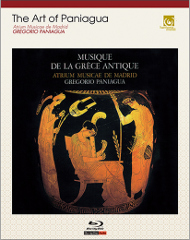| Review by Joseph Ponessa September 30, 2014 (1 of 1 found this review helpful)
|
Performance:  |
There are no encyclopedia entries on Gregorio Paniagua, but a Google search coughed up the tidbit that his matronymic (the second of the two Hispanic last names) was Axivil. Another site calls him "Gorio Paniagua Rodriguez" -- but if they got the first name wrong, can they be trusted with the last one? According to the more reliable site, he was born in 1910 in Almería and died in 1988.
Gregorio Paniagua founded the Atrium Musicae de Madrid in 1964. They were involved in a ground-breaking recording of Cantigas de Santa Maria in 1968, and later issued six monumental recordings of instrumental music from antiquity, the middle ages and the renaissance: TARENTULE-TARENTELLE and AL ANDALUS MUSIQUE ARABO-ANDALOUSE in 1976, MUSIQUE DE LA GRÈCE ANTIQUE in 1978, VILLANCICOS in 1979, LA FOLIA and LA SPAGNA in 1980. All six of these have been released on SACD, LA SPAGNA from BIS in a wonderful transfer (soon set to appear as an audiophile LP) and the rest from Harmonia Mundi.
The Harmonia Mundi releases appeared a couple of years ago in Japan as part of the five-disc boxed set THE ART OF PANIAGUA. Now they have released the same set of five discs in a blu-ray boxed set. Since redundancy is the best way to safeguard material, I now have both the SACD and the blu-ray incarnations of this set. In fact, I have the MUSIQUE DE LA GRÈCE ANTIQUE on LP, CD, SACD and BD. So let me use that title as the point of comparison:
LP -- The original vinyl release has exhaustive liner notes about each of the fragmentary selections in the program. None of the subsequent releases have matched these notes. The CD has maybe a third of the material in its little booklet, the SACD and BD have only Japanese notes and not many of them. So, although I got rid of most of my vinyl last year, I am still clinging to this one for dear life.
CD -- The CD combines the 24 pieces into 22 chapters (combining 2 and 3, and then the last two). However, there is no loss of material. The booklet reproduces all the information from the back cover of the LP jacket, but none of the detailed description of source and dates that filled the centerfold of the LP.
SACD -- The SACD is single-layer and cannot be read by a regular CD player. Therefore I am hanging onto the CD also. The SACD sound is spectacular, however, and much to be preferred. It was not easy getting my hands on the limited-edition SACD set, but with the help of a friend a copy was found in a Japanese shop. Thanks for this and so much else, Nicolas! The SACD has nice metadata that is read by my OPPO and displayed on the screen, so I know where I am in the dense thicket of material. Also the number of chapters is properly expanded to 24.
BD -- The BD box set came out, and the little angel on the left shoulder and the little angel on the right had quite a tug-of-war over this one, but not wanting to wait until the last copy was sold, I made the plunge. The set came yesterday and I am very pleased with it. One drawback is that the onscreen titles are all in Japanese. With so many short titles on each of the discs, I can get quite lost while listening. In fact I had a completely different disc in than I thought and didn't discover my mistake until the end, when I saw the title on the back of the disc. The sound quality is maybe better than the SACD -- the SACD is more in-your-face, but the BD is smoother and gentler. It depends on whether you want to be attacked by ancient music or not.
So I'm keeping the BD for the sound, the SACD for the metadata, the CD for the expanded option of playback and the LP for the liner notes. For the potential buyer, I say, get the CD and the BD. You'll have some explanatory notes then with the fine recording.
|
Was this review helpful to you?
yes |
no
|
|

